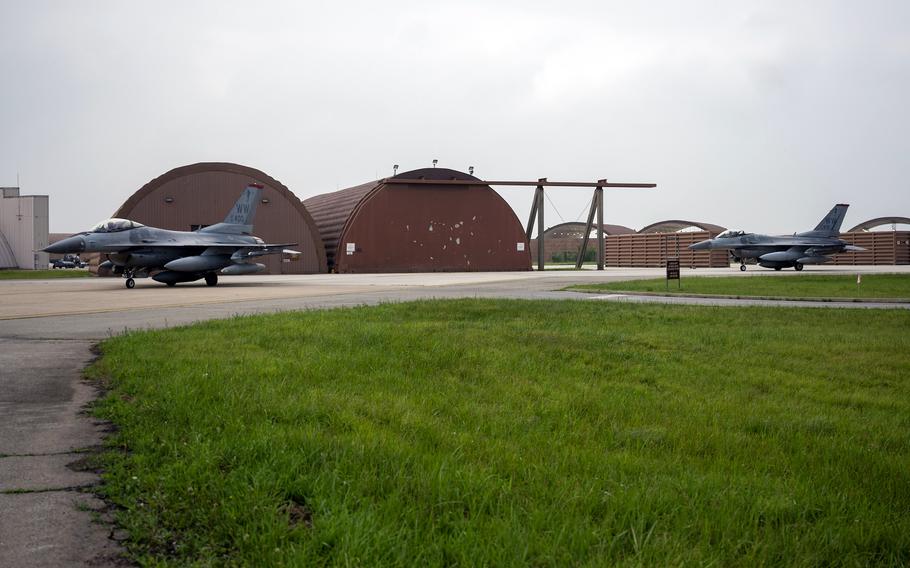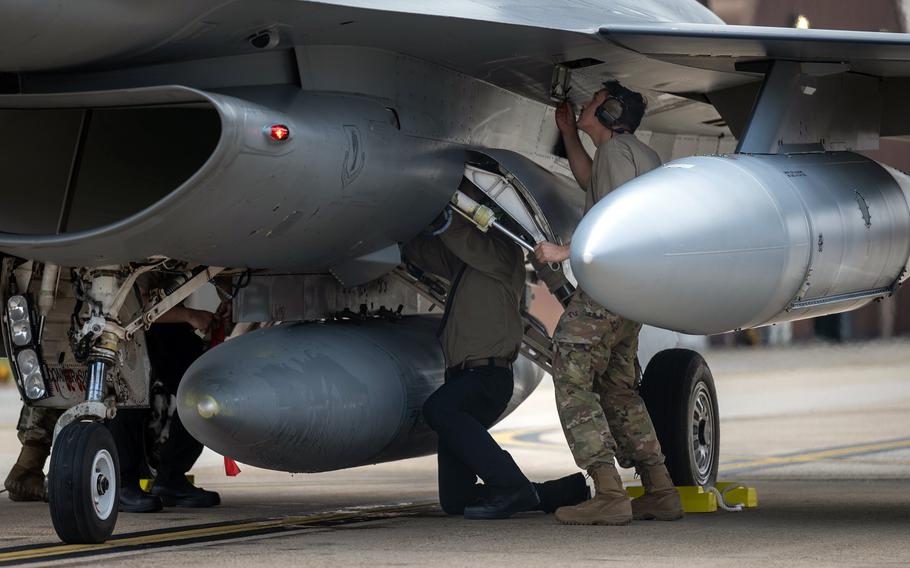
F-16 Fighting Falcons arrive at Osan Air Base, South Korea, from Misawa Air Base in northeastern Japan, June 26, 2025. (Sarah Williams/U.S. Air Force)
The U.S. Air Force has transferred upgraded F-16 Fighting Falcons from Japan to South Korea, reinforcing its fighter capabilities on the Korean Peninsula amid ongoing efforts to deter airborne threats.
The 51st Fighter Wing at Osan Air Base — home to the 7th Air Force, about 30 miles south of Seoul — received the aircraft from the 35th Fighter Wing at Misawa Air Base in northeastern Japan, said Maj. Kippun Sumner, spokesman for the 51st.
He declined to say in an email Thursday how many aircraft had arrived June 26-27 or whether personnel accompanied them, citing operational security.
“We will continue to work towards upgrading our defensive capabilities and ensuring we are ready … against any adversary that threatens the peace and security of the [South Korea]-U.S. alliance,” he wrote.
The F-16s feature upgraded avionics that bring their capabilities closer to those of fifth-generation fighters, such as the F-35 Lightning II, according to a Tuesday news release from the 51st Fighter Wing. Avionics include the aircraft’s systems for flight control, navigation, communication and threat detection.
The 35th Fighter Wing will receive no replacement F-16s from the transfer, the Misawa-based unit said in an unattributed email Thursday. There will be “no decrement in capability” from the transition due to an overlap with existing military assets, the message said.
The Air Force began a $6.3 billion effort in 2022 to upgrade its fleet of 608 F-16s, which were first delivered in 1978.
“These upgrades enhance our game a bit,” Chief Master Sgt. Robert Parsons, of the 25th Fighter Generation Squadron, said in the release. “The F-16’s new features give pilots greater spatial awareness, helping them see the battlefield more clearly.”
Instead of retrofitting its existing F-16s, the 51st Fighter Wing opted to acquire upgraded jets from Misawa as part of its modernization strategy, Sumner said.
It was critical to have capable aircraft now, instead of waiting for a new airframe, according to Parsons.
“The F-16 already has an established support system in place for supply, personnel, equipment, and training,” he said. “With these upgrades, we now have the aircraft we need, ready and available today.”
Sumner said the transfer is unrelated to the 7th Air Force’s initiative to create temporary “super squadrons” in South Korea. That program aims to test whether squadrons of 31 F-16s from Osan can generate more sorties with fewer resources. The first such unit was formed in July 2024, with a second scheduled to be tested in October using F-16s originally from Kunsan Air Base, about 75 miles south of Osan.

An Air Force crew chief inspects an F-16 Fighting Falcon that was transferred from Misawa Air Base, Japan, to Osan Air Base, South Korea, June 26, 2025. (Sarah Williams/U.S. Air Force)
Last year, the 7th Air Force announced plans to upgrade its F-16s and retire A-10 Thunderbolt IIs, a close-air support aircraft, starting in January.
“The strategy bolsters deterrence against North Korea and reaffirms the ironclad U.S. security commitment to the South Korea-U.S. alliance by strengthening South Korean and U.S. combined defense,” the service said in a Nov. 13 news release.
The Department of Defense has also announced plans to modernize other Pacific-based forces. It will replace 36 F-16s at Misawa with 48 F-35As and swap out 48 F-15C/D Eagles with 36 F-15EXs at Kadena Air Base, Okinawa, over the next several years, according to a news release July 3, 2024.